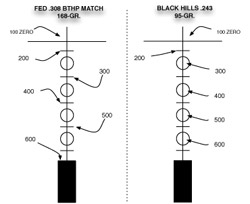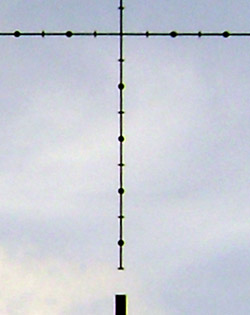Shooting Tips
Calculating Mil-Dot Reticle Holdovers
The mil-dot reticle -- found in Millett LRS and TRS scopes -- has proved popular with tactical and long-range shooters as an accurate means of calculating distances; it is, in fact, the most precise way to do so, short of a laser rangefinder. Another and less understood capability of this reticle is to provide useful aiming points or holdovers for quick long-range shooting. Let's put this in context, and then see how it's done. Because a bullet's trajectory is a curve that increases sharply with distance, a rifleman must lift his muzzle to compensate. The old-fashioned way is simply to know how high to hold at a given distance, then "hold over" that height to strike the target. For instance, a .308 rifle firing a 168-gr. boat tail match round with a 100-yard zero, would impact 35.5 inches low at 400 yards. Since the shooter knows this, he aims what he reckons to be that height (35.5 inches) over his 400-yard target, fires, and hits it. Holdover is very fast because the shooter's eye never leaves his scope. However, even if he has an accurate range estimate, it lacks precision because the shooter must hold a "guestimated" height over his target.
There is another, much more accurate way, which is to employ holdover aiming points. Here's the good news: With a mil-dot reticle you can calculate accurate holdovers for ANY cartridge's trajectory.
 "Very BEST MIL DOT SIZE" – One mil is the distance from the center of one dot to the center of the next dot.
"Very BEST MIL DOT SIZE" – One mil is the distance from the center of one dot to the center of the next dot.Understanding Those Mils
First, understand that the term, "mil-dot" is a misnomer – the DOT is not one mil. The SPACE FROM CENTER-DOT TO CENTER- DOT is one mil, which is an angular measurement that widens with distance. One mil at 100 yards equals 3.6 inches, and by the time the distance is 1000 yards, that same one mil will have widened by ten times to 36 inches. The distance is ten times further, so the mil represents a space that's ten times larger – get it?
Here's what the distance from dot-to-dot measures at 100-yard increments. No matter which cartridge holdovers you calculate, you always use the data below for the width of a mil, from dot-to-dot.
One Mil's Size at Various Distances (in Yards)
| 100 | 200 | 300 | 400 | 500 | 600 | 700 | 800 | 900 | 1000 |
|---|---|---|---|---|---|---|---|---|---|
| 3.6" | 7.2" | 10.8" | 14.4" | 18.0" | 21.6" | 25.2" | 28.8" | 32.4" | 36.0" |
What if you use the metric system? The principle and proportions are the same, except you employ centimeters and meters rather than inches and yards, as shown below.
 "reticle final" – Although a mil-dot reticle is 10 mils high and 10 mils wide, only the lower 5 mils are used as holdover points.
"reticle final" – Although a mil-dot reticle is 10 mils high and 10 mils wide, only the lower 5 mils are used as holdover points.One Mil's Size at Various Distances (in Meters)
| 100 | 200 | 300 | 400 | 500 | 600 | 700 | 800 | 900 | 1000 |
|---|---|---|---|---|---|---|---|---|---|
| 10cm | 20cm | 30cm | 40cm | 50cm | 60cm | 70cm | 80cm | 90cm | 1 Meter |
Now, look closely at the mil-dot reticle shown below. It contains ten mils vertically and ten mils horizontally, but not all these mils are bordered by dots. The innermost dot, in the center where the crosshairs intersect, was removed to allow the finest possible aiming. From this intersection there are four dots in each direction, with the fifth or outermost mil measured at the edge of the thick line. Therefore, the reticle contains a total of ten mil-sized spaces vertically, and ten mil-sized spaces horizontally.
Now, I don't want to confuse you, but most variable magnification scopes put the reticle in the second focal plane – which means the mil size is only in synch at one magnification. Most often this is at the highest magnification, such as 25x on the Millett LRS scope. Make sure you know the proper magnification to ensure that one mil equals one mil.
Converting Trajectory Data to Mil Holdovers
To calculate holdovers you must first obtain your round's trajectory data. Look at the ammunition manufacturer's website, in a manufacturer's brochure, or use a ballistic software program – for this article I used Sierra's Infinity Five Suite. All you need is the Bullet Path data for a 100-yard zero, in hundred-yard increments.
Now here's an important point: For holdover purposes, you only use the five mils below the center of the crosshair. That's because you'll compensate for your bullet's drop by holding high. Thus you need not calculate more than 5 mils of holdover because that's the maximum potential.
I'll talk you through the process, referring to the following data on the Federal .308 168-gr. BTHP Match Round and a 100-yard zero. To start with, in the left column I listed the cartridge's trajectory in inches at 100-yard increments. The next column contains the mil-size in inches at these same distances. All I had to do was divide the trajectory by the mil size at each distance to find the holdover in mils – bingo! And finally I rounded the mil holdovers so I'd have precise holdover points in my reticle. This is especially easy with Millett's Mil Dotbar reticle, which contains fine lines as halfway points between the mil dots.
Federal .308 168-gr BTHP Holdovers for a Mil-Dot Reticle
| Distance | Trajectory | 1 Mil's Size | Actual Holdover | Rounded Holdover | |
|---|---|---|---|---|---|
| 100 Yards | Zero | divide by | 3.6" | =0 Mils | 0 Mils |
| 200 Yards | -4.5" | divide by | 7.2" | =0.62 Mils | ½ Mil |
| 300 Yards | -15.9" | divide by | 10.8" | =1.47 Mils | 1-1/2 Mils |
| 400 Yards | -35.5" | divide by | 14.4" | =2.46 Mils | 2-1/2 Mils |
| 500 Yards | -64.6" | divide by | 18.0" | =3.58 Mils | 3-1/2 Mils |
| 600 Yards | -105" | divide by | 21.6" | =4.86 Mils | 5 Mils |
Obviously, by rounding I have lessened precision to some degree, but how much? How close are these holdovers to the actual trajectory? The data below compares my resulting holdovers to the .308, 168-gr. round's real trajectory and they're pretty darned close. All the way to 500 yards the holdovers are 1.6 inches or closer to the true trajectory, and at 600 yards it's off only 3 inches.
Mil-Dot Reticle Holdovers Compared to Actual .308 168-gr Trajectory
| Rounded Holdover | Holdover Equals | Actual Trajectory | How Close? | |
|---|---|---|---|---|
| 100 Yards | 0 Mils | 0" | Zero | --- |
| 200 Yards | ½ Mil | 3.6" | -4.5" | 1.1" Low |
| 300 Yards | 1-1/2 Mils | 16.2" | -15.9" | 0.3" High |
| 400 Yards | 2-1/2 Mils | 36.0" | -35.5" | 0.5" High |
| 500 Yards | 3-1/2 Mils | 63.0" | -64.6" | 1.6" Low |
| 600 Yards | 5 Mils | 108.0" | -105" | 3.0" High |
Let's try this process again to see how well mil holdovers work for a cartridge having a distinctly different trajectory, the Black Hills .243 Winchester, 95-gr. This is depicted below. Although it required only 4 mils of holdover to reach 600 yards, by 700 yards it exceeded 5 mils, so I did not depict holdovers beyond 600 yards.
Black Hills .243 Winchester, 95-gr. Holdovers for a Mil-Dot Reticle
| Distance | Trajectory | 1 Mil's Size | Actual Holdover | Rounded Holdover | |
|---|---|---|---|---|---|
| 100 Yards | Zero | divide by | 3.6" | =0 Mils | 0 Mils |
| 200 Yards | -3.3" | divide by | 7.2" | =0.46 Mils | ½ Mil |
| 300 Yards | -12.2" | divide by | 10.8" | =1.13 Mils | 1 Mil |
| 400 Yards | -28.1" | divide by | 14.4" | =1.95 Mils | 2 Mils |
| 500 Yards | -52.4" | divide by | 18.0" | =2.91 Mils | 3 Mils |
| 600 Yards | -87.0" | divide by | 21.6" | =4.02 Mils | 4 Mils |
Now observe, below, how impressively close these rounded holdover points are to the exact trajectory at each range. And think of how fast a shooter could fire using these holdover points!
Mil-Dot Reticle Holdovers Compared to Actual .243, 95-gr. Trajectory
| Rounded Holdover | Holdover Equals | Actual Trajectory | How Close? | |
|---|---|---|---|---|
| 100 Yards | 0 Mils | 0" | Zero | --- |
| 200 Yards | ½ Mil | 3.6" | -3.3" | 0.3" High |
| 300 Yards | 1 Mil | 10.8" | -12.2" | 1.45" Low |
| 400 Yards | 2 Mils | 28.8" | -28.1" | 0.66" High |
| 500 Yards | 3 Mils | 54.0" | -52.4" | 1.57" High |
| 600 Yards | 4 Mils | 86.4" | -87.0" | 0.63" Low |
Aiming with Mil Reticle Holdovers
 "mil holdover cards" – The final product – a simple sketch of the holdover points. The .308 is left, and .243 on the right.
"mil holdover cards" – The final product – a simple sketch of the holdover points. The .308 is left, and .243 on the right. "MILLETT MIL holdovers" – The Millett Mil-Dot Bar reticle with half-mil bars offers excellent aiming points for hold-over shooting.
"MILLETT MIL holdovers" – The Millett Mil-Dot Bar reticle with half-mil bars offers excellent aiming points for hold-over shooting.This process has generated a bunch of data and some pretty clear holdovers, but how do you carry this around in your head? How do you actually apply it?
The best way I've devised is to draw the lower half of a mil-dot reticle on a 3 x 5 card, as shown in the illustration below. With bold arrows I indicate the exact aiming points and the range for that holdover. The card on the left displays aiming points for the .308 round, and the one on the right for the .243 Winchester cartridge. Carefully note that you count from crosshair center DOWN -- that is, the first mil is measured from the crosshair to the first dot below it, and so on, with the fifth and final mil being the edge of the thick line below. All that data and calculations have become a simple sketch that I cover with acetate or clear tape so I can carry it with me to visualize the holdovers and eventually memorize them.
And once you've memorized the holdovers, as quickly as you estimate the distance to a target, you're capable of getting off a well-aimed shot.
Just how well-aimed? Observe the following image, showing the lower half of a Millet Mil-Dot Bar reticle. The Millett dot is only 0.72 inches wide at 100 yards, which makes it just 3.6 inches at 500 yards – not even the width of a prairie dog.
For best results, I emphasize, aim carefully and make SURE your scope's magnification is in synch with the correct mil size when using these holdovers. Happy shooting.
